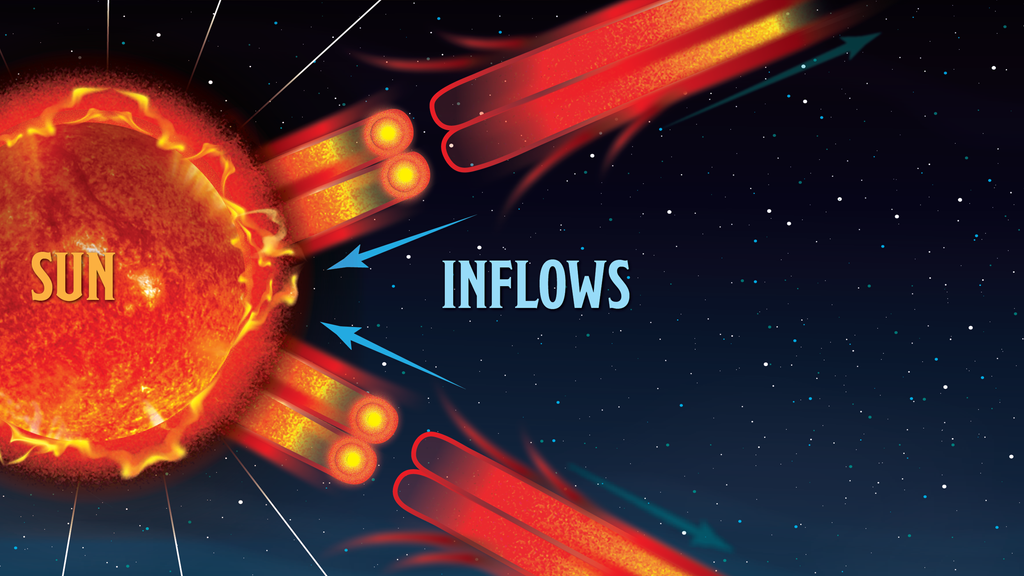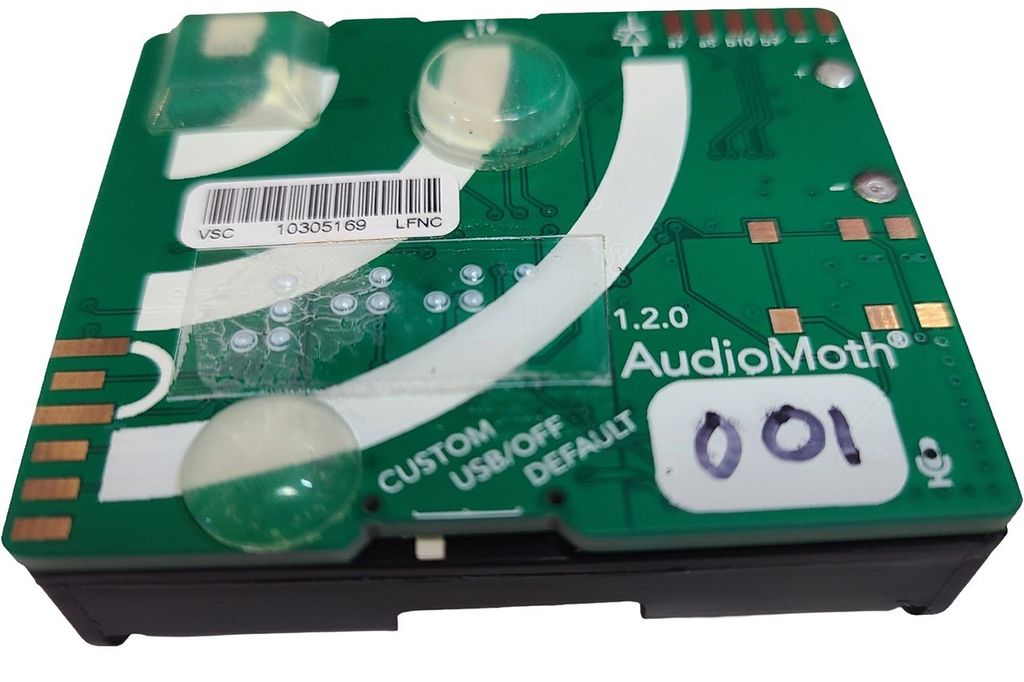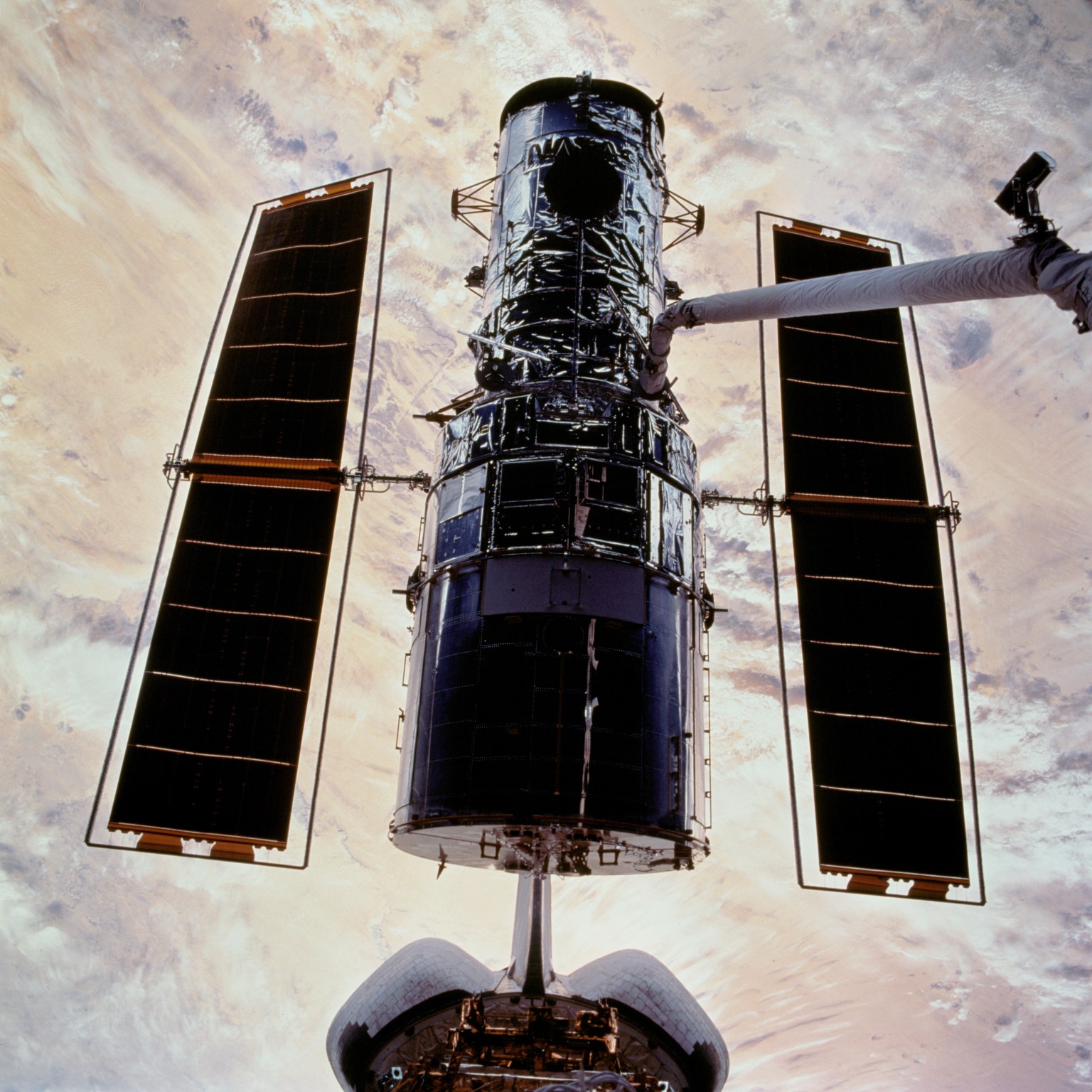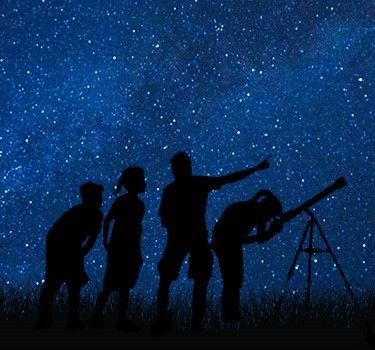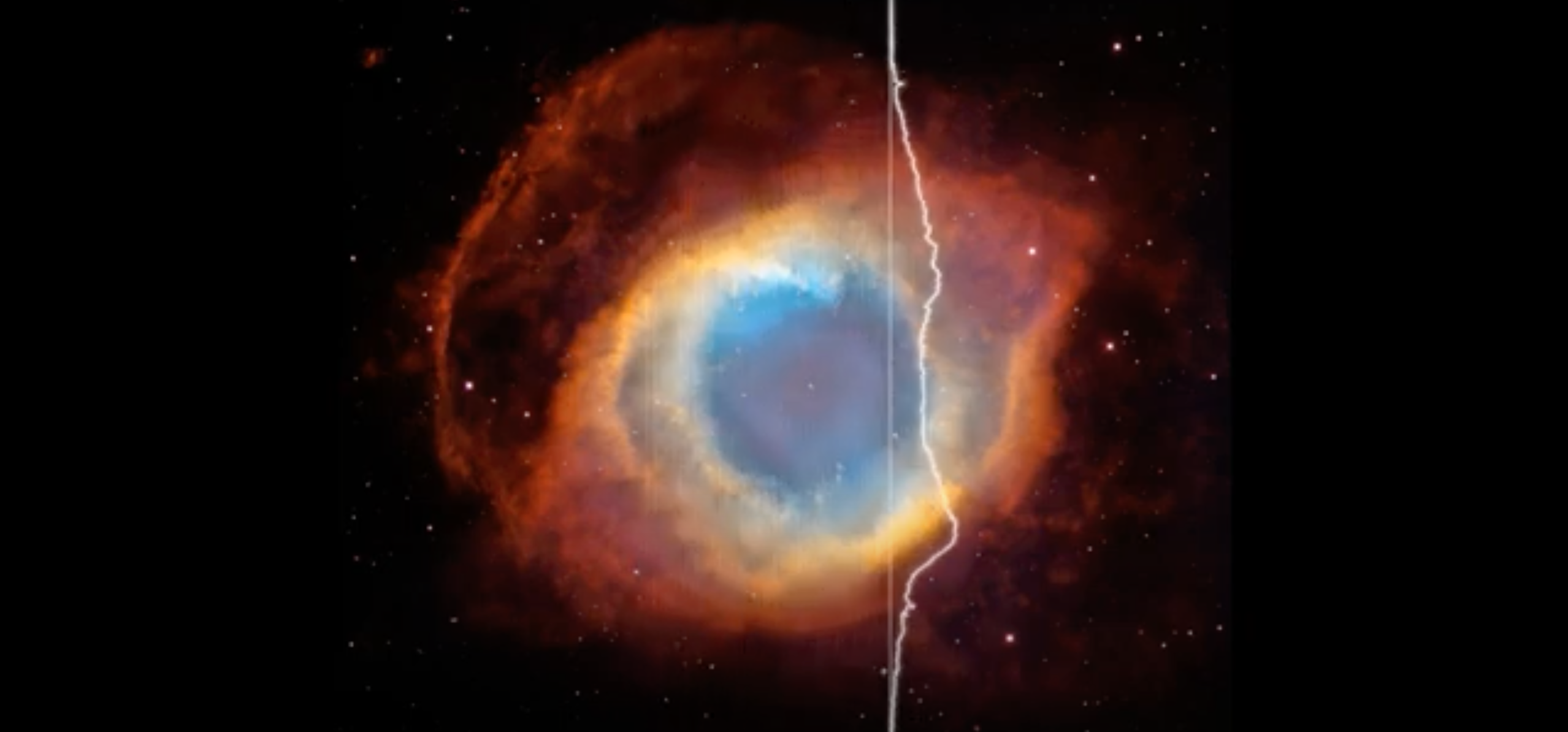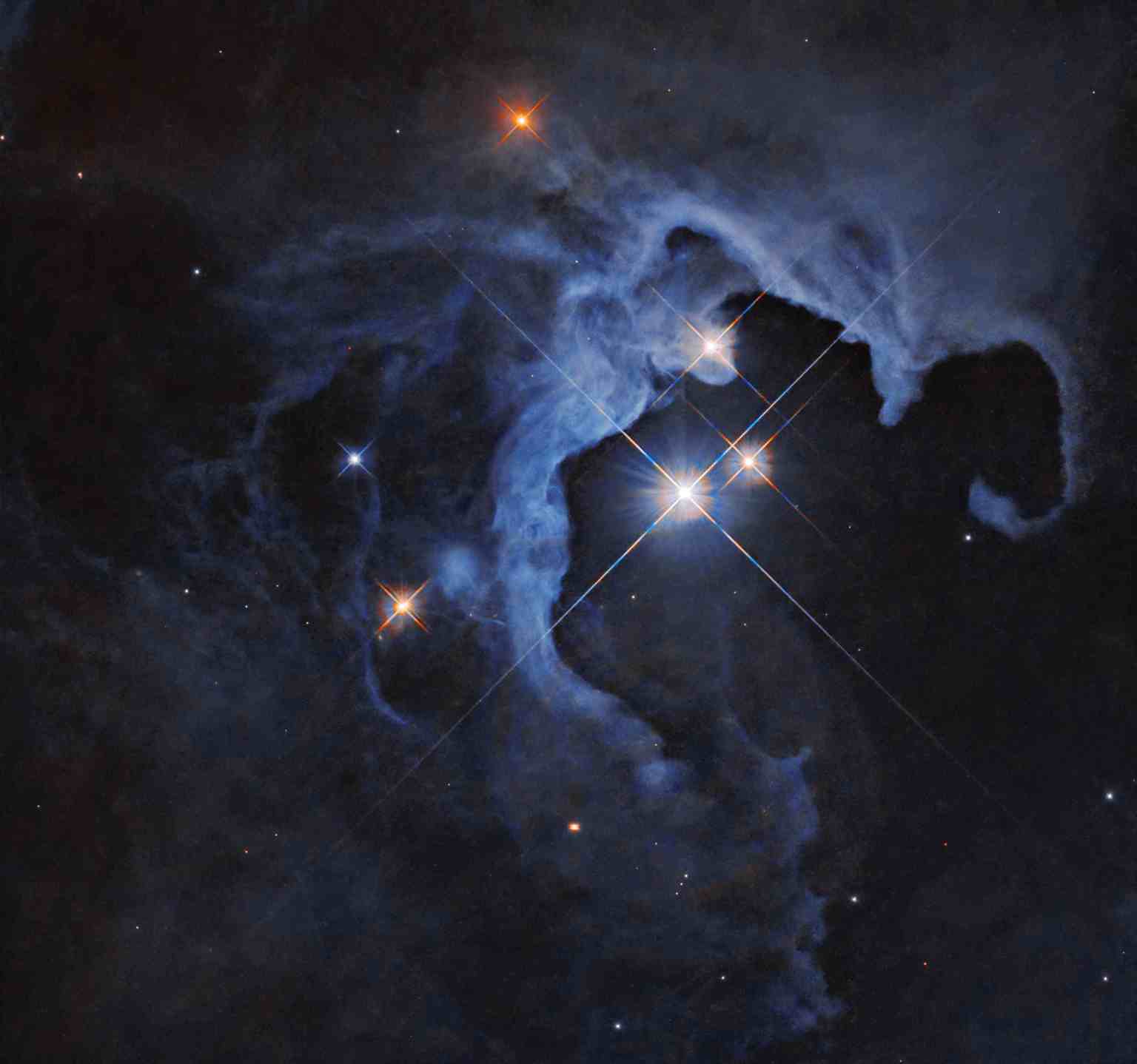35 Years of Images
Celebrate Hubble's 35th anniversary with a countdown of images the observatory captured over its lifetime, one for each year in orbit.

Join our countdown to Hubble’s 35th birthday with an iconic image from each year of the mission, leading up to a series of new anniversary images. Follow along on social media for daily updates!
35 Years of Hubble Images
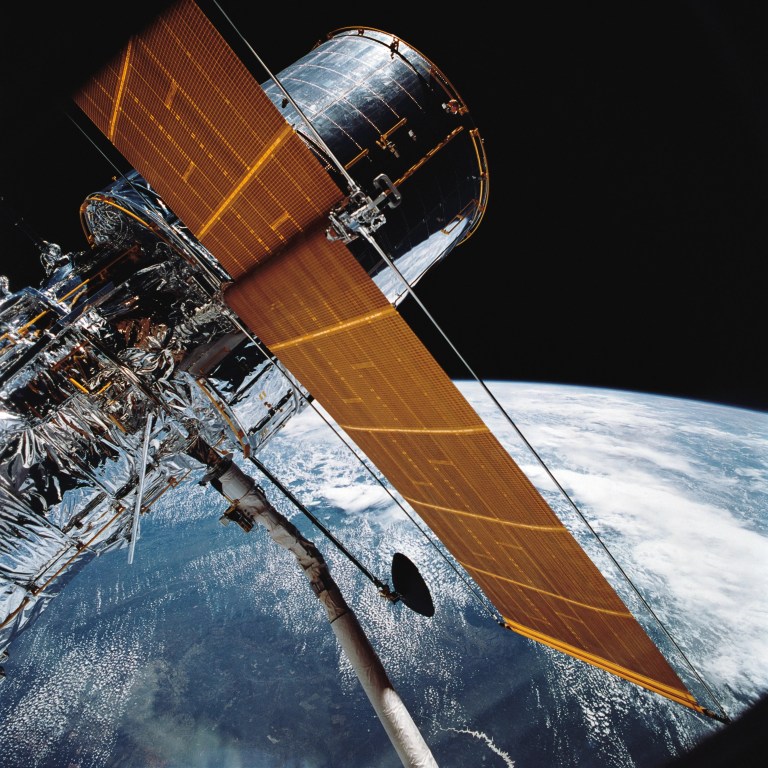
Hubble after deployment with Earth Below
In this April 25, 1990 photograph taken with a handheld Hasselblad camera, most of the school-bus-sized Hubble Space Telescope is visible suspended in space by Discovery's Remote Manipulator System following the deployment of part of its solar panels and antennae. This was among the first photos NASA released on April 30 from the five-day STS-31 mission.

STS-31 Liftoff with Hubble in the Cargo Bay
The Hubble Space Telescope launched on April 24, 1990, aboard the Space Shuttle Discovery (STS-31), and deployed into Earth orbit the following day, marking the beginning of its 35 years of exploring the cosmos.

Year 1 - Major Storm on Saturn
These Hubble images show Saturn's white spot, a great storm in the planet's equatorial region, discovered by amateur astronomers in September, 1990. Such storms are rare: the last one previous to this storm in the equatorial region occurred in 1933. The storm extends completely around the planet, in some places appearing as great masses of clouds and in others as well organized turbulence. Knowing that this storm is probably a once in a lifetime event, scientists and engineers of a special White Spot Observing Team, the Wide Field/Planetary Camera Team, the Space Telescope Science Institute, and the Goddard Space Flight center reprogrammed Hubble's observing schedule and were able to get several days of Saturn observations in mid-November 1990, shortly before Saturn moved too near in the sky to the Sun for safe observations by Hubble.

Year 2 - Core and Jet of M87
Astronomers reported in 1992 that they found intriguing evidence that a black hole weighing over 2.6 billion times the mass of the Sun exists at the center of the giant elliptical galaxy M87, based upon images taken by Hubble. The images show that stars become strongly concentrated toward the center of M87, as if drawn into the center and held there by the gravitational field of a massive black hole. M87 is at the center of a nearby cluster of galaxies in the constellation of Virgo, 52 million light- years distant, and contains more than 100 billion stars. One of the brightest galaxies in the local universe, M87 is visible in even small telescopes.
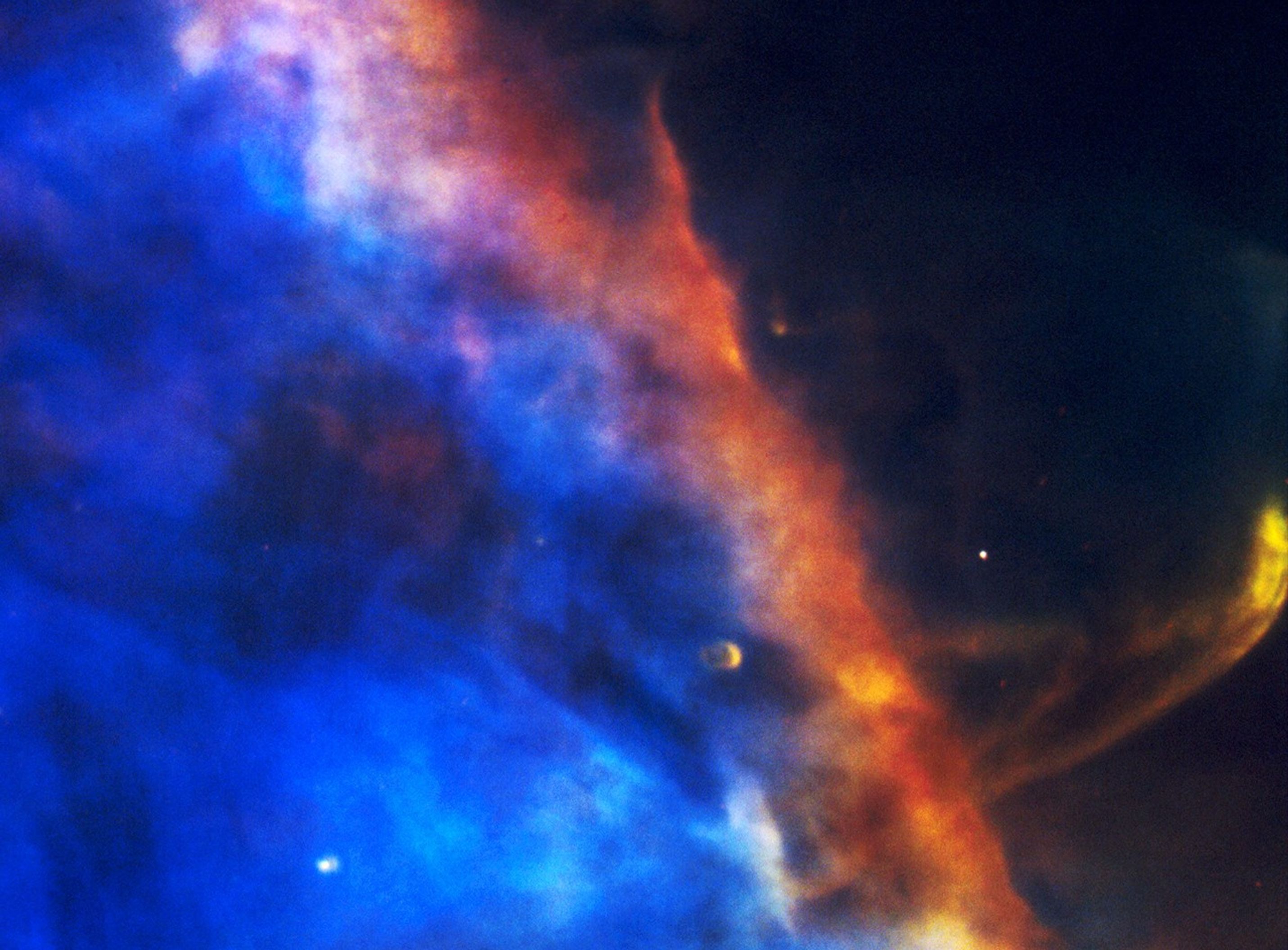
Year 3 - M42 Gas Plume & Proplyds
This Hubble image shows a hypersonic shock wave (lower right) of material moving at 148,000 miles per hour in the Orion Nebula, a star-forming region 1,500 light-years away. Studies of similar objects infer that such highly supersonic shock waves are formed by a beam of material coming out of newly formed stars. The plume is only 1,500 years old. The image is 112 light-year across. This color photograph is a composite of separate images taken at the wavelengths of the two abundant elements in the nebula: Hydrogen and Oxygen.
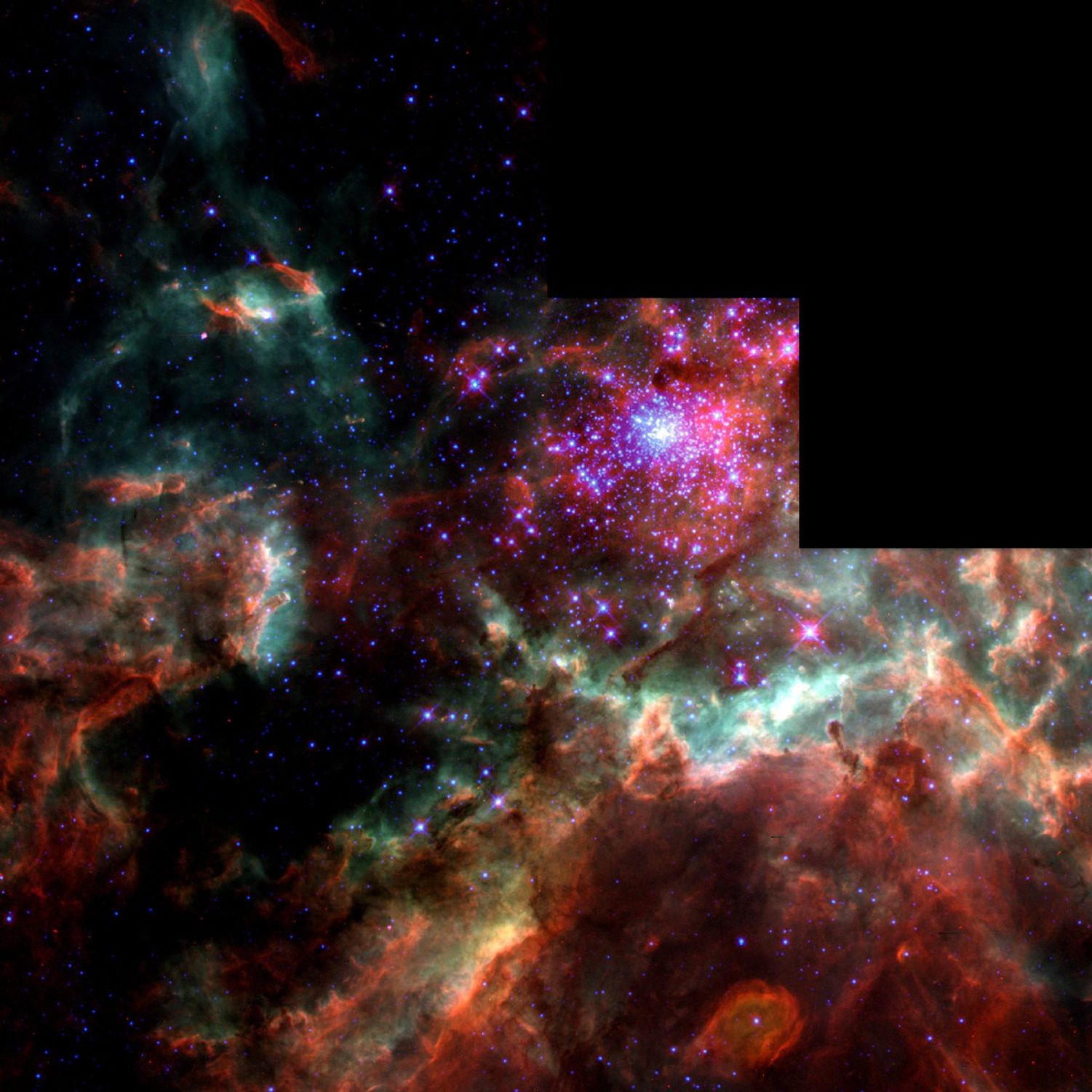
Year 4 - Star Cluster R136
This 1994 Hubble image shows a massive, young stellar grouping called R136. The cluster is only a few million years old and resides in the 30 Doradus Nebula, a turbulent star-birth region in the Large Magellanic Cloud (LMC), a satellite galaxy of our Milky Way. There is no known star-forming region in our galaxy as large or as prolific as 30 Doradus.

Year 5 - Comet Shoemaker-Levy 9 impact
This Hubble image of Jupiter shows eight impact sites from the Comet Shoemaker-Levy 9 impact in 1994. The comet, which was discovered in 1993, broke into 21 fragments during a close passage by Jupiter in July of 1992.
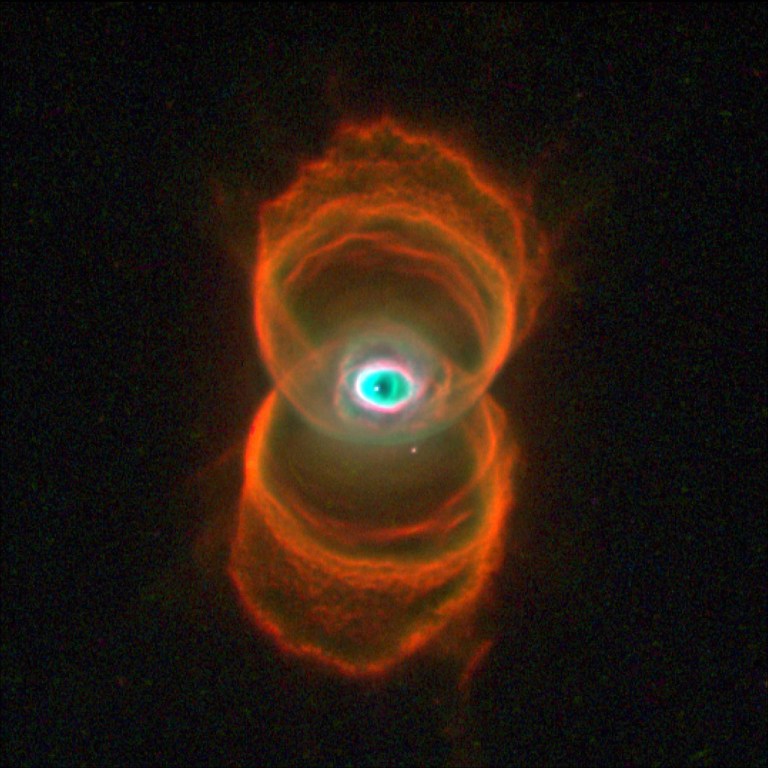
Year 6 - Hour Glass Nebula
This Hubble snapshot of MyCn18, a young planetary nebula, reveals that the object has an hourglass shape with an intricate pattern of "etchings" in its walls. A planetary nebula is the glowing relic of a dying, Sun-like star. The results are of great interest because they shed new light on the poorly understood ejection of stellar matter that accompanies the slow death of Sun-like stars. According to one theory on the formation of planetary nebulae, the hourglass shape is produced by the expansion of a fast stellar wind within a slowly expanding cloud, which is denser near its equator than near its poles.

Year 7 - Eta Carinae
Hubble captured a huge, billowing pair of gas and dust clouds in this stunning Hubble image of the supermassive star Eta Carinae. Even though Eta Carinae is more than 8,000 light-years away, structures 10 billion miles across (about the diameter of our solar system) can be distinguished. Dust lanes, tiny condensations, and strange radial streaks all appear with unprecedented clarity.
Eta Carinae was the site of a giant outburst about 150 years ago, when it became one of the brightest stars in the southern sky. Though the star released as much visible light as a supernova explosion, it survived the outburst. Somehow, the explosion produced two polar lobes and a large thin equatorial disk, all moving outward at about 1.5 million miles per hour.

Year 8 - Antennae Galaxies
This Hubble image captures the Antennae Galaxies, a pair of colliding galaxies. The collision started some 200 to 300 million years ago, making the pair of galaxies one of the nearest and youngest examples of colliding galaxies. The respective cores of the twin galaxies are the orange blobs, left and right of image center, crisscrossed by filaments of dark dust. A wide band of chaotic dust, called the overlap region, stretches between the cores of the two galaxies. The sweeping spiral- like patterns, traced by bright blue star clusters, shows the result of a firestorm of star birth activity which was triggered by the collision.

Year 9 - Southern Ring Nebula NGC 3132
NGC 3132 is a striking example of a planetary nebula. This expanding cloud of gas, surrounding a dying star, is known to amateur astronomers in the southern hemisphere as the "Eight-Burst" or the "Southern Ring" Nebula. NGC 3132 is nearly half a light-year in diameter, and at a distance of about 2,000 light-years is one of the nearer known planetary nebulae. The gases are expanding away from the central star at a speed of 9 miles per second. This Hubble image clearly shows two stars near the center of the nebula, a bright white one, and an adjacent, fainter companion to its upper right. (A third, unrelated star lies near the edge of the nebula.) The faint partner is actually the star that has ejected the nebula.

Year 10 - Abell 2218
Scanning the heavens for the first time since the successful December 1999 servicing mission, in 2000 Hubble imaged a giant, cosmic magnifying glass, a massive cluster of galaxies called Abell 2218. This "hefty" cluster resides in the constellation Draco, some 2 billion light-years from Earth. The cluster is so massive that its enormous gravitational field deflects light rays passing through it, much as an optical lens bends light to form an image. This phenomenon, called gravitational lensing, magnifies, brightens, and distorts images from faraway objects. The cluster's magnifying ability provides a powerful "zoom lens" for viewing distant galaxies that normally could not be observed with the largest telescopes. This useful phenomenon produces the arc-shaped patterns found throughout the Hubble picture. These "arcs" are the distorted images of very distant galaxies, which lie 5 to 10 times farther than the lensing cluster.

Year 11 - Spirograph Nebula
Glowing like a multi-faceted jewel, the planetary nebula IC 418 lies about 2,000 light-years from Earth in the direction of the constellation Lepus. A planetary nebula represents the final stage in the evolution of a star similar to our Sun. The star at the center of IC 418 was a red giant a few thousand years ago, but then ejected its outer layers into space to form the nebula, which has now expanded to a diameter of about 0.1 light-year. The stellar remnant at the center is the hot core of the red giant, from which ultraviolet radiation floods out into the surrounding gas, causing it to fluoresce. Over the next several thousand years, the nebula will gradually disperse into space, and then the star will cool and fade away for billions of years as a white dwarf. Our own Sun is expected to undergo a similar fate, but fortunately this will not occur until some 5 billion years from now.

Year 12 - Mars
Frosty white water ice clouds and swirling orange dust storms above a vivid rusty landscape reveal Mars as a dynamic planet in this Hubble image. Hubble captured the planet on June 26, 2001, when Mars was approximately 43 million miles (68 million km) from Earth — the closest Mars had been to Earth since 1988. Hubble can see details as small as 10 miles (16 km) across. Especially striking is the large amount of seasonal dust storm activity seen in this image. One large storm system is churning high above the northern polar cap [top of image], and a smaller dust storm cloud can be seen nearby.

Year 13 - Seyfert's Sextet
Hubble witnessed a grouping of galaxies engaging in a slow dance of destruction that will last for billions of years. The galaxies are so tightly packed together that gravitational forces are beginning to rip stars from them and distort their shapes. Those same gravitational forces eventually could bring the galaxies together to form one large galaxy. This grouping's name, Seyfert's Sextet, implies that six galaxies are participating in the action, but only four galaxies are on the dance card. The small face-on spiral with the prominent arms [center] of gas and stars is a background galaxy almost five times farther away than the other four. Only a chance alignment makes it appear as if it is part of the group. The sixth member of the sextet isn't a galaxy at all but a long "tidal tail" of stars [below, right] torn from one of the galaxies. The group resides 190 million light-years away in the constellation Serpens and spans just 100,000 light-years, occupying less volume than the Milky Way galaxy. Each galaxy is about 35,000 light-years wide.

Year 14 - Helix Nebula
This photograph of the coil-shaped Helix Nebula is one of the largest and most detailed celestial images ever made. The composite picture is a seamless blend of ultra-sharp images from Hubble combined with the wide view of the Mosaic Camera on the National Science Foundation's 0.9-meter telescope at Kitt Peak National Observatory near Tucson, Ariz. The image shows a fine web of filamentary "bicycle-spoke" features embedded in the colorful red and blue ring of gas. At 650 light-years away, the Helix is one of the nearest planetary nebulae to Earth.
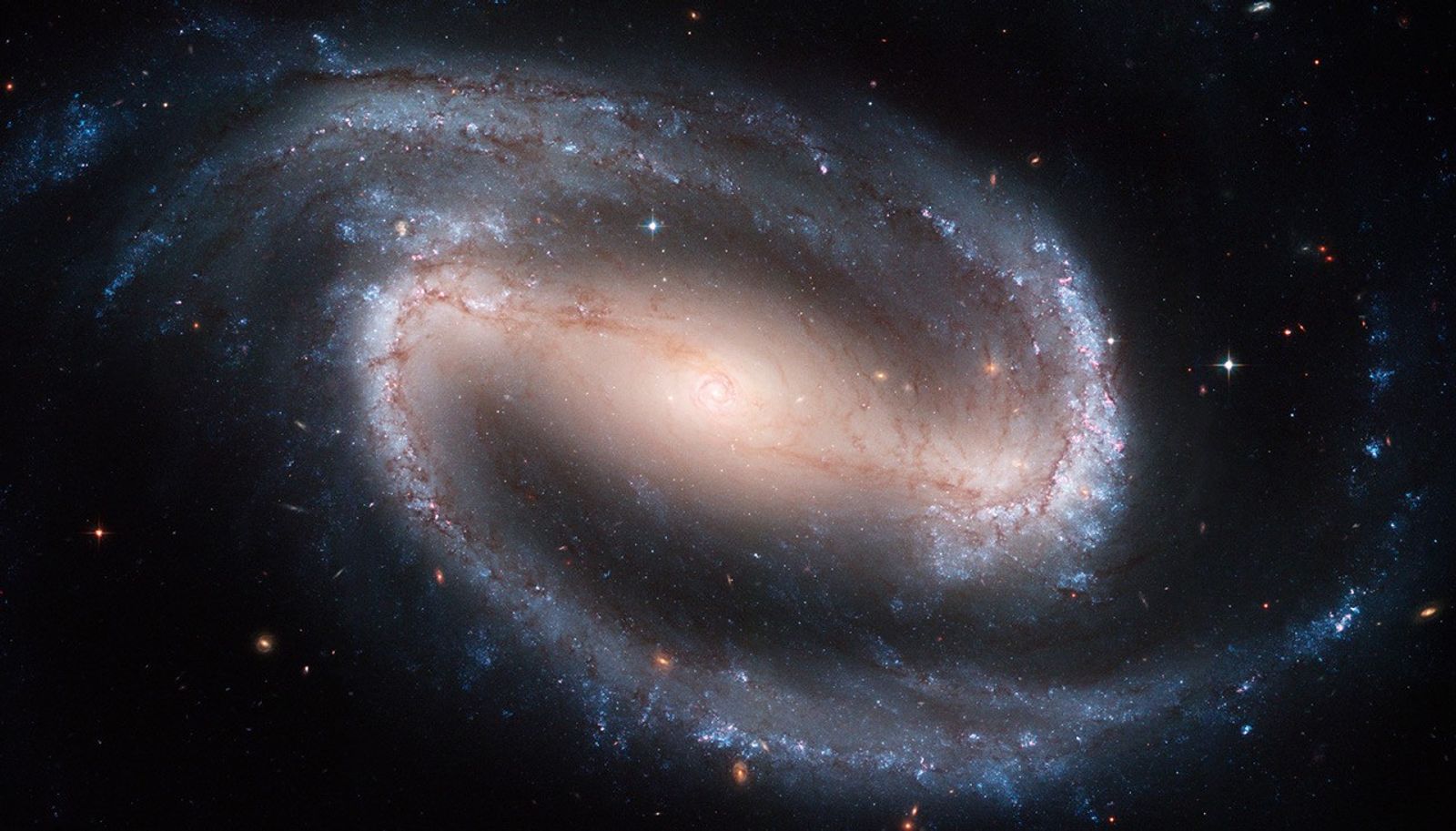
Year 15 - NGC 1300
Hubble captured a display of starlight, glowing gas, and silhouetted dark clouds of interstellar dust in this 4-foot-by-8-foot image of the barred spiral galaxy NGC 1300. NGC 1300 is prototypical of barred spiral galaxies. Barred spirals differ from normal spiral galaxies in that the arms of the galaxy do not spiral all the way into the center, but are connected to the two ends of a straight bar of stars containing the nucleus at its center. At Hubble's resolution, a myriad of fine details, some of which have never before been seen, are visible throughout the galaxy's arms, disk, bulge, and nucleus. Blue and red supergiant stars, star clusters, and star-forming regions are well resolved across the spiral arms, and dust lanes trace out fine structures in the disk and bar. Numerous distant galaxies are visible in the background, even through the densest regions of NGC 1300.

Year 16 - Crab Nebula
This is a mosaic image, one of the largest ever taken by Hubble of the Crab Nebula, is a six-light-year-wide expanding remnant of a star's supernova explosion. Japanese and Chinese astronomers recorded this violent event nearly 1,000 years ago in 1054, as did, almost certainly, Native Americans. The orange filaments are the tattered remains of the star and consist mostly of hydrogen. The rapidly spinning neutron star embedded in the center of the nebula is the dynamo powering the nebula's eerie interior bluish glow. The blue light comes from electrons whirling at nearly the speed of light around magnetic field lines from the neutron star. The neutron star, like a lighthouse, ejects twin beams of radiation that appear to pulse 30 times a second due to the neutron star's rotation. A neutron star is the crushed ultra-dense core of the exploded star.

Year 17 - V838 Monocerotis
This Hubble image shows an unusual phenomenon in space called a light echo. Light from a star that erupted nearly five years before the image was taken continued propagating outward through a cloud of dust surrounding the star. The light reflects or "echoes" off the dust and then travels to Earth. Because of the extra distance the scattered light travels, it reaches Earth long after the light from the stellar outburst itself. Therefore, a light echo is an analog of a sound echo produced, for example, when sound from an Alpine yodeler echoes off of the surrounding mountainsides. The echo comes from the unusual variable star V838 Monocerotis (V838 Mon), located 20,000 light-years away on the periphery of our Galaxy. In early 2002, V838 Mon increased in brightness temporarily to become 600,000 times brighter than our Sun. The reason for the eruption is still unclear.

Year 18 - NGC 6397
This glittering image captures a globular cluster called NGC 6397, which sits 7,800 light-years away, making it one of the closest globular clusters to Earth. The cluster's blue stars are near the end of their lives. These stars have used up their hydrogen fuel that makes them shine. Now they are converting helium to energy in their cores, which fuses at a higher temperature resulting in a blue color. The reddish glow is from red giant stars that have consumed their hydrogen fuel and have expanded in size. The myriad small white objects include stars like our Sun.

Year 19 - Jupiter and Ganymede
Hubble caught Jupiter's moon Ganymede playing a game of "peek-a-boo." In this crisp Hubble image, we see Ganymede just before it ducks behind the giant planet. Ganymede completes an orbit around Jupiter every seven days. Because Ganymede's orbit is tilted nearly edge-on to Earth, it routinely appears to pass in front of and disappear behind its giant host, only to reemerge later. Composed of rock and ice, Ganymede is the largest moon in our solar system. It is even larger than Mercury, but looks like a dirty snowball next to large Jupiter.

Year 20 - 30 Doradus
This Hubble image captures hundreds of brilliant blue stars wreathed by warm, glowing clouds. The festive portrait is the most detailed view of the largest stellar nursery in our local galactic neighborhood. The massive, young stellar grouping, called R136, is only a few million years old and resides in the 30 Doradus Nebula, a turbulent star-birth region in the Large Magellanic Cloud, a satellite galaxy of our Milky Way. There is no known star-forming region in our galaxy as large or as prolific as 30 Doradus. Many of the diamond-like icy blue stars are among the most massive stars known. Several of them are over 100 times more massive than our Sun. These hefty stars are destined to pop off, like a string of firecrackers, as supernovas in a few million years.

Year 21 - Starburst Cluster NGC 3603
This young, glittering collection of stars is surrounded by clouds of interstellar gas and dust – the raw material for new star formation. The nebula, located 20,000 light-years away in the constellation Carina, contains a central cluster of huge, hot stars, called NGC 3603. This environment is not as peaceful as it looks. Ultraviolet radiation and violent stellar winds have blown out an enormous cavity in the gas and dust enveloping the cluster, providing an unobstructed view of the cluster. NGC 3603 contains some of the most massive stars known. These huge stars live fast and die young, burning through their hydrogen fuel quickly and ultimately ending their lives in supernova explosions.

Year 22 - NGC 2841
This Hubble image reveals a majestic disk of stars and dust lanes in the spiral galaxy NGC 2841. A bright cusp of starlight marks the galaxy's center. Spiraling outward are dust lanes that are silhouetted against the population of whitish middle-aged stars. Much younger blue stars trace the spiral arms. Notably missing are pinkish emission nebulae indicative of new star birth. It is likely that the radiation and supersonic winds from fiery, super-hot, young blue stars cleared out the remaining gas (which glows pink), and hence shut down further star formation in the regions in which they were born. NGC 2841 currently has a relatively low star formation rate compared to other spirals that are ablaze with emission nebulae. NGC 2841 lies 46 million light-years away in the constellation of Ursa Major (The Great Bear).

Year 23 - Extreme Deep Field
The eXtreme Deep Field, or XDF, was assembled by combining 10 years of Hubble data taken of a patch of sky at the center of the original Hubble Ultra Deep Field. The XDF is a small fraction of the angular diameter of the full Moon. The Hubble Ultra Deep Field is an image of a small area of space in the constellation Fornax, created using Hubble Space Telescope data from 2003 and 2004. By collecting faint light over many hours of observation, it revealed thousands of galaxies, both nearby and very distant, making it the deepest image of the universe ever taken at that time. The full-color XDF image reaches much fainter galaxies, and includes very deep exposures in red light from Hubble's infrared camera, enabling new studies of the earliest galaxies in the universe. The XDF contains about 5,500 galaxies even within its smaller field of view. The faintest galaxies are one ten-billionth the brightness of what the human eye can see. Hubble pointed at a tiny patch of southern sky in repeat visits (made over the past decade) for a total of 50 days, with a total exposure time of 2 million seconds. More than 2,000 images of the same field were taken with Hubble's two premier cameras – the Advanced Camera for Surveys and the Wide Field Camera 3, which extends Hubble's vision into near-infrared light – and combined to make the XDF.
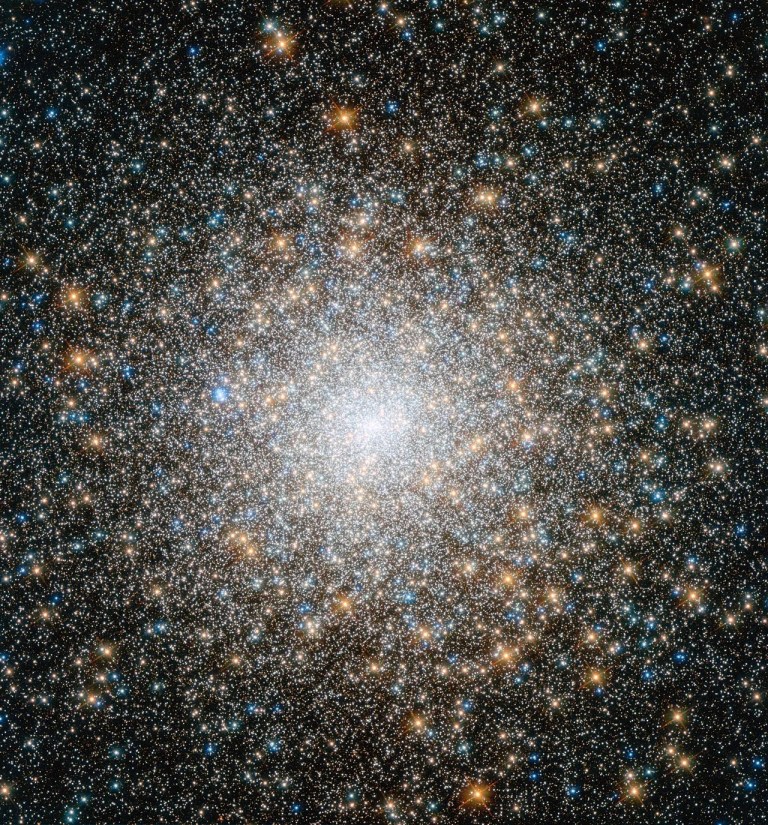
Year 24 - Messier 15
This cluster of stars is known as Messier 15, and is located some 35,000 light-years away in the constellation of Pegasus (The Winged Horse). It is one of the oldest globular clusters known, with an age of around 12 billion years. Both very hot blue stars and cooler golden stars can be seen swarming together in the image, becoming more concentrated toward the cluster's bright center. Messier 15 is one of the densest globular clusters known, with most of its mass concentrated at its core. As well as stars, Messier 15 was the first cluster known to host a planetary nebula, and it has been found to have a rare type of black hole at its center.

Year 25 - Andromeda galaxy
This was the largest Hubble Space Telescope image ever assembled at the time. It offers a sweeping bird's-eye view of a portion of the Andromeda galaxy (M31) and is the sharpest large composite image taken of our galactic next-door neighbor. Though the galaxy is over 2 million light-years away, Hubble is powerful enough to resolve individual stars in the 61,000-light-year-long stretch of the galaxy's pancake-shaped disk seen here. It's like photographing a beach and resolving individual grains of sand.

Year 26 - Herbig-Haro 24 Jet
This Hubble image shows a newborn star shooting twin jets out into space as a sort of birth announcement to the universe. It lies inside a turbulent birthing ground for new stars known as the Orion B molecular cloud complex, located 1,350 light-years away. When stars form within giant clouds of cool molecular hydrogen, some of the surrounding material collapses under gravity to form a rotating, flattened disk encircling the newborn star. Though planets will later congeal in the disk, at this early stage the protostar is feeding on the disk. Gas from the disk rains down onto the protostar and engorges it. Superheated material spills away and is shot outward from the star in opposite directions along an uncluttered escape route – the star's rotation axis. Shock fronts develop along the jets and heat the surrounding gas to thousands of degrees Fahrenheit. The jets collide with the surrounding gas and dust and clear vast spaces, like a stream of water plowing into a hill of sand. The shock fronts form tangled, knotted clumps of nebulosity and are collectively known as Herbig-Haro (HH) objects. The prominent HH object shown in this image is HH 24.

Year 27 - NGC 248
Hubble captured two festive-looking nebulae, situated so as to appear as one. They reside in the Small Magellanic Cloud, a dwarf galaxy that is a satellite of our Milky Way galaxy. Intense radiation from the brilliant central stars is heating hydrogen in each of the nebulas, causing them to glow red. The nebulae, together, are called NGC 248. They were discovered in 1834 by the astronomer Sir John Herschel. NGC 248 is about 60 light-years long and 20 light-years wide. It is among a number of glowing hydrogen nebulas in the dwarf satellite galaxy, which is located approximately 200,000 light-years away in the southern constellation Tucana.

Year 28 - Milky Way bulge
This Hubble image of a sparkling jewel box full of stars captures the heart of our Milky Way galaxy. Aging red giant stars coexist with their more plentiful younger cousins, the smaller, white, Sun-like stars, in this crowded region of our galaxy’s ancient central hub, or bulge. Most of the bright blue stars in the image are probably recently formed stars located in the foreground, in the galaxy's disk. Astronomers studied 10,000 of these Sun-like stars in archival Hubble images over a nine-year period to unearth clues to our galaxy’s evolution.
The study reveals that the Milky Way’s bulge is a dynamic environment of variously aged stars zipping around at different speeds, like travelers bustling about a busy airport. The center of our galaxy is about 26,000 light-years away.

Year 29 - M100
This stunning spiral galaxy is Messier 100 in the constellation Coma Berenices, captured here by the the Hubble Space Telescope. M100 is a beautiful example of a grand-design spiral galaxy, and this Hubble image reveals individual stars within the galaxy’s prominent spiral arms. These dusty structures swirl around the galaxy’s nucleus and are marked by a flurry of star formation. M100’s characteristic arms also host several small black holes, including the youngest one ever observed in our cosmic neighborhood. M100 is located 56 million light-years away from Earth and appears dim in the night sky.

Year 30 - Arp-Madore 2026-424
When astronomers peer deep into space, they don't expect to find something staring back at them.
In this Hubble image, an uncanny pair of glowing eyes glares menacingly in our direction. The piercing "eyes" are the most prominent feature of what resembles the face of an otherworldly creature. But this is no ghostly apparition. Hubble is looking at a titanic head-on collision between two galaxies. Each "eye" is the bright core of a galaxy, one of which slammed into another. The outline of the face is a ring of young blue stars. Other clumps of new stars form a nose and mouth. The entire system is catalogued as Arp-Madore 2026-424 (AM 2026-424), from the Arp-Madore "Catalogue of Southern Peculiar Galaxies and Associations."
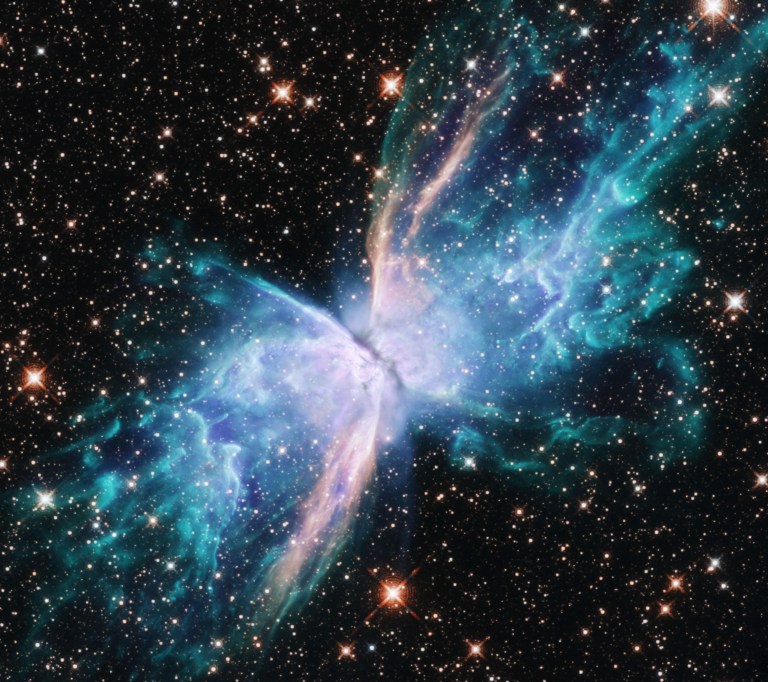
Year 31 - Caldwell 69: Butterfly Nebula
Caldwell 69 is an example of one of the more spectacular Hubble images from the Caldwell Catalog of objects. In 2020, the Hubble observed Caldwell 69, also known as NGC 6302, or the "Butterfly Nebula," to view it across a more complete spectrum of light, from near-ultraviolet to near-infrared, helping researchers better understand the mechanics at work in its technicolor "wings" of gas. The observations highlighted a new pattern of near-infrared emission from singly ionized iron, which traces an S shape from lower left to upper right. This iron emission likely traces the central star systems most recent ejections of gases, which are moving at much faster speeds than the previously expelled mass. The star or stars at its center are responsible for the nebula's appearance. In their death throes, they have cast off layers of gas periodically over the past couple thousand years. The "wings" of NGC 6302 are regions of gas heated to more than 36,000 degrees Fahrenheit that are tearing across space at more than 600,000 miles an hour. NGC 6302 lies between 2,500 and 3,800 light-years away in the constellation Scorpius.

Year 32 - CW Leonis
This Hubble image captures the red giant star CW Leonis. The orange-red "cobwebs" are dusty clouds of sooty carbon engulfing the dying star. They were created when CW Leonis threw out its outer layers into the inky black void. The carbon, cooked up through nuclear fusion in the star's interior, gives it a carbon-rich atmosphere. Blasting the carbon back into space provides raw material for the formation of future stars and planets. All known life on Earth is built around the carbon atom. Complex biological molecules consist of carbon atoms bonded with other common elements in the universe. At a distance of 400 light-years from Earth, CW Leonis is the closest carbon star. This gives astronomers the chance to understand the interplay between the star and its surrounding, turbulent envelope. The complex inner structure of shells and arcs may be shaped by the star’s magnetic field. Detailed Hubble observations of CW Leonis taken over the last two decades also show the expansion of threads of ejected material around the star.
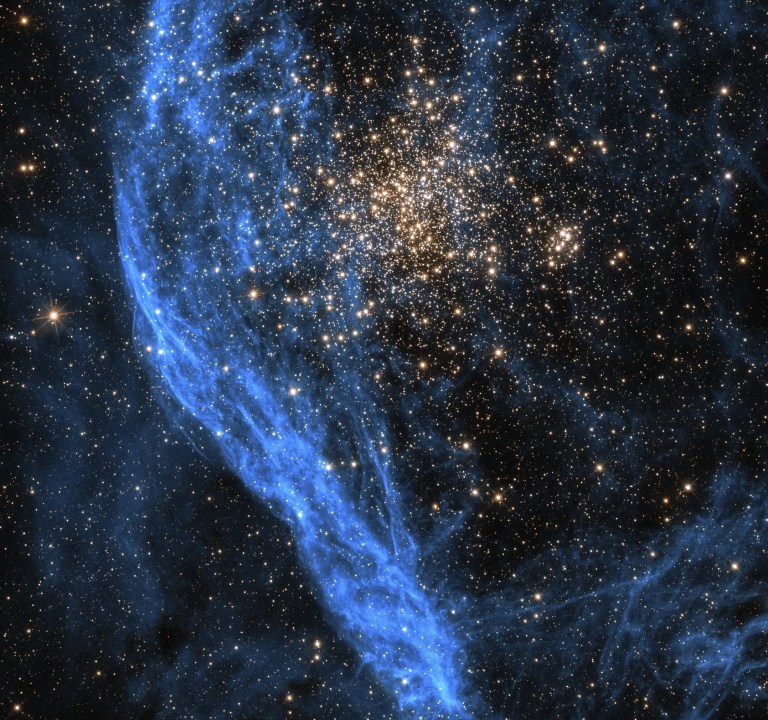
Year 33 - NGC 1850
The double cluster NGC 1850, found in one of our neighboring galaxies, the Large Magellanic Cloud, is an eye-catching object. It is a young, "globular-like" star cluster - a type of object unknown in our own Milky Way Galaxy. Moreover, NGC 1850 is surrounded by a filigree pattern of diffuse gas, which scientists believe was created by the explosion of massive stars. This Hubble image is a good example of the interaction between gas, dust, and stars. Millions of years ago massive stars in the main cluster exploded as supernovas, forming the spectacular filigree pattern of diffuse gas visible in the image. It is believed that the birth of new stars can be triggered by the enormous forces in the shock fronts where the supernova blast waves hit and compress the gas. The nebulous gas is part of the N103 super bubble and looks similar to the well-known supernova remnant Cygnus Loop in our own Milky Way.

Year 34 - HP Tau
Looking like a glittering cosmic geode, a trio of dazzling stars blaze from the hollowed-out cavity of a reflection nebula in this new image from NASA’s Hubble Space Telescope. The triple-star system is made up of the variable star HP Tau, HP Tau G2, and HP Tau G3. HP Tau is known as a T Tauri star, a type of young variable star that hasn’t begun nuclear fusion yet but is beginning to evolve into a hydrogen-fueled star similar to our Sun. T Tauri stars tend to be younger than 10 million years old ― in comparison, our Sun is around 4.6 billion years old ― and are often found still swaddled in the clouds of dust and gas from which they formed. As with all variable stars, HP Tau’s brightness changes over time. T Tauri stars are known to have both periodic and random fluctuations in brightness. The random variations may be due to the chaotic nature of a developing young star, such as instabilities in the accretion disk of dust and gas around the star, material from that disk falling onto the star and being consumed, and flares on the star’s surface. The periodic changes may be due to giant sunspots rotating in and out of view. Curving around the stars, a cloud of gas and dust shines with their reflected light. Reflection nebulae do not emit visible light of their own, but shine as the light from nearby stars bounces off the gas and dust, like fog illuminated by the glow of a car’s headlights. HP Tau is located approximately 550 light-years away in the constellation Taurus. Hubble studied HP Tau as part of an investigation into protoplanetary disks, the disks of material around stars that coalesce into planets over millions of years.

Year 35 - Mars Near Opposition 2024
This is a combination of Hubble images of Mars taken from December 28th to 30th, 2024. At the midpoint of the observations, Mars was approximately 61 million miles from Earth. Thin water-ice clouds that are apparent in ultraviolet light give the Red Planet a frosty appearance. The icy northern polar cap was experiencing the start of Martian spring. In the left image, the bright orange Tharsis plateau is visible with its chain of dormant volcanoes. The largest volcano, Olympus Mons, pokes above the clouds at the 10 o’clock position near the northwest limb. At an elevation of 70,000 feet, it is 2.5 times the height of Mt. Everest above sea level. Valles Marineris, Mars’ 2,500-mile-long canyon system, is a dark, linear, horizontal feature near center left. In the right image, high-altitude evening clouds can be seen along the planet’s eastern limb. The 1,400-mile-wide Hellas basin, an ancient asteroid impact feature, appears far to the south. Most of the hemisphere is dominated by the classical “shark fin” feature, Syrtis Major.

Year 35 - Planetary Nebula NGC 2899
This Hubble image captures the beauty of the moth-like planetary nebula NGC 2899. This object has a diagonal, bipolar, cylindrical outflow of gas. This is propelled by radiation and stellar winds from a nearly 40,000-degree-Fahrenheit white dwarf at the center. In fact, there may be two companion stars that are interacting and sculpting the nebula, which is pinched in the middle by a fragmented ring or torus – looking like a half-eaten donut. It has a forest of gaseous “pillars” that point back to the source of radiation and stellar winds. The colors are from glowing hydrogen and oxygen. The nebula lies approximately 4,500 light-years away in the southern constellation Vela.

Year 35 - Dark Clouds in Rosette Nebula
This is a Hubble image of a small portion of the Rosette Nebula, a huge star-forming region spanning 100 light-years across and located 5,200 light-years away. Hubble zooms into a small portion of the nebula that is only 4 light-years across (the approximate distance between our Sun and the neighboring Alpha Centauri star system.) Dark clouds of hydrogen gas laced with dust are silhouetted across the image. The clouds are being eroded and shaped by the seething radiation from the cluster of larger stars in the center of the nebula (NGC 2440). An embedded star seen at the tip of a dark cloud in the upper right portion of the image is launching jets of plasma that are crashing into the cold cloud around it. The resulting shock wave is causing a red glow. The colors come from the presence of hydrogen, oxygen, and nitrogen.

Year 35 - NGC 5335
NASA’s Hubble Space Telescope captured in exquisite detail a face-on view of a remarkable-looking galaxy. NGC 5335 is categorized as a flocculent spiral galaxy with patchy streamers of star formation across its disk. There is a striking lack of well-defined spiral arms that are commonly found among galaxies, including our Milky Way. A notable bar structure slices across the center of the galaxy. The bar channels gas inwards toward the galactic center, fueling star formation. Such bars are dynamic in galaxies and may come and go over two-billion-year intervals. They appear in about 30 percent of observed galaxies, including our Milky Way.
Credit: NASA's Goddard Space Flight Center; Lead Producer: Paul Morris; Narrator: Dr. Jennifer Wiseman; Images & Visualizations: NASA, ESA, STScI.
Eye on Infinity: NASA Celebrates Hubble’s 35th Year in Orbit
In celebration of the Hubble Space Telescope’s 35 years in Earth orbit, NASA is releasing an assortment of compelling images…
Read the Story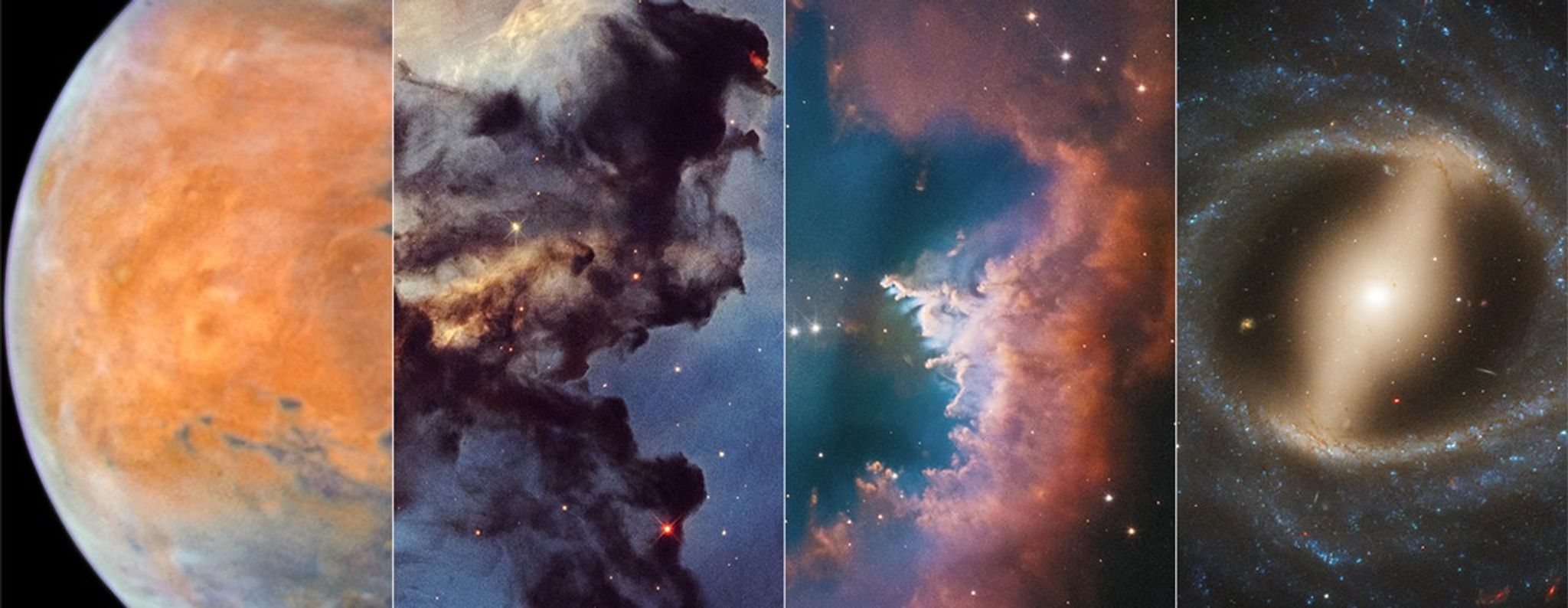
Hubble History, Benefits, and Science
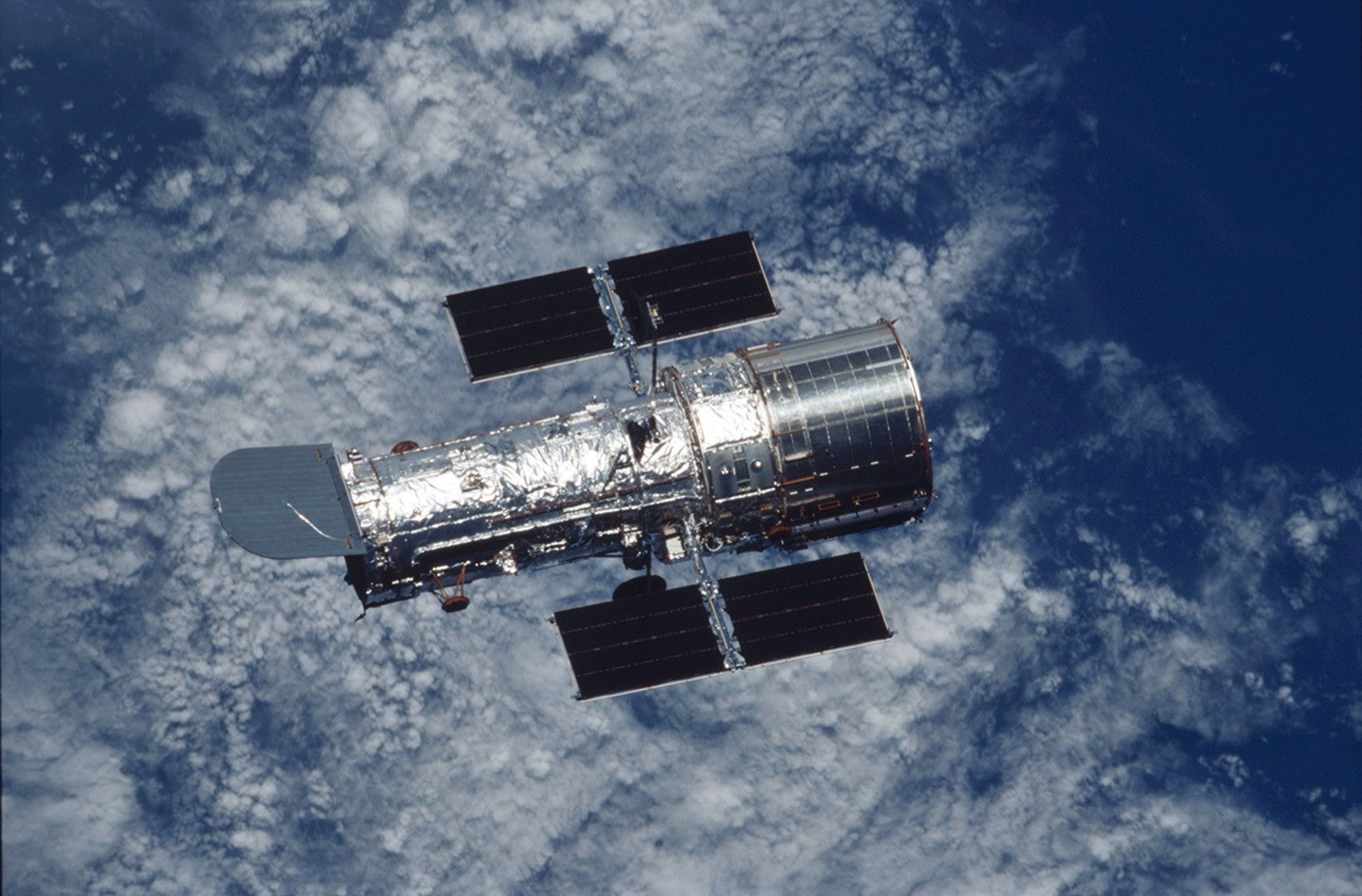
The History of Hubble
Since the time of Galileo and his telescope, astronomers have struggled with a constant obstacle to their view of the cosmos: Earth's atmosphere. But that changed with Hubble.
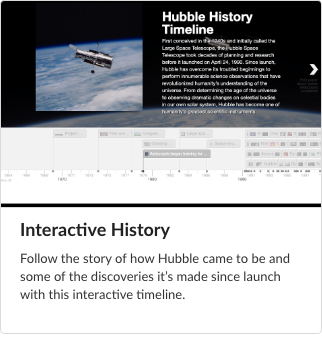
Hubble Timelines
Hubble History Timeline, Scientific Discoveries Timeline, and Servicing Missions Timeline.
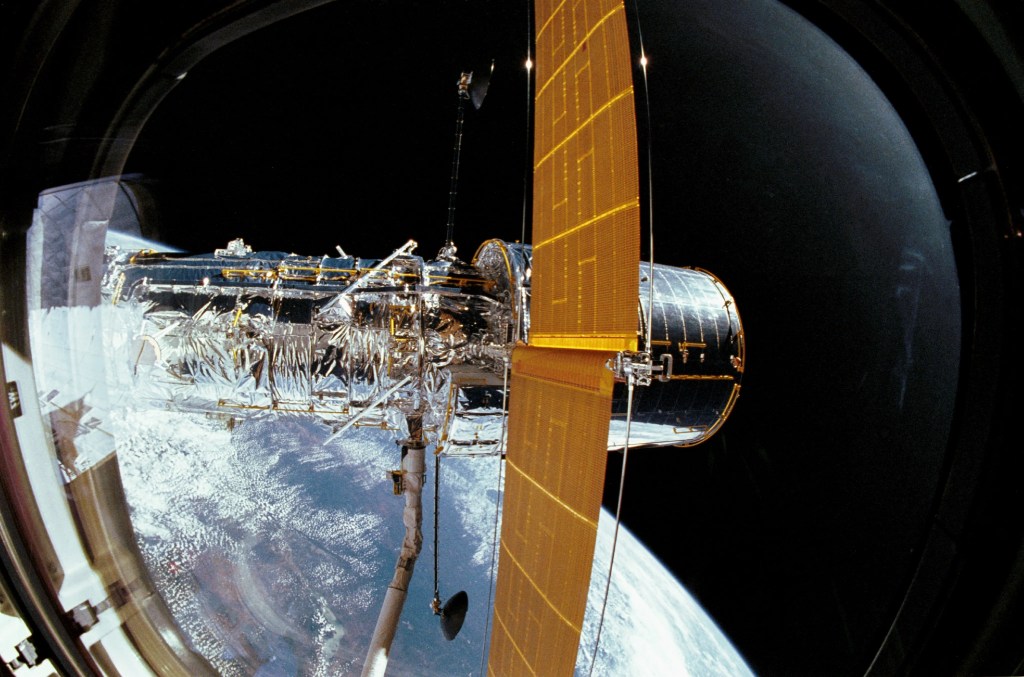
Impacts and Benefits
Hubble became a household word by expanding our knowledge of the cosmos and for its spectacular images. But the telescope also impacted our technologies, industries, and culture.
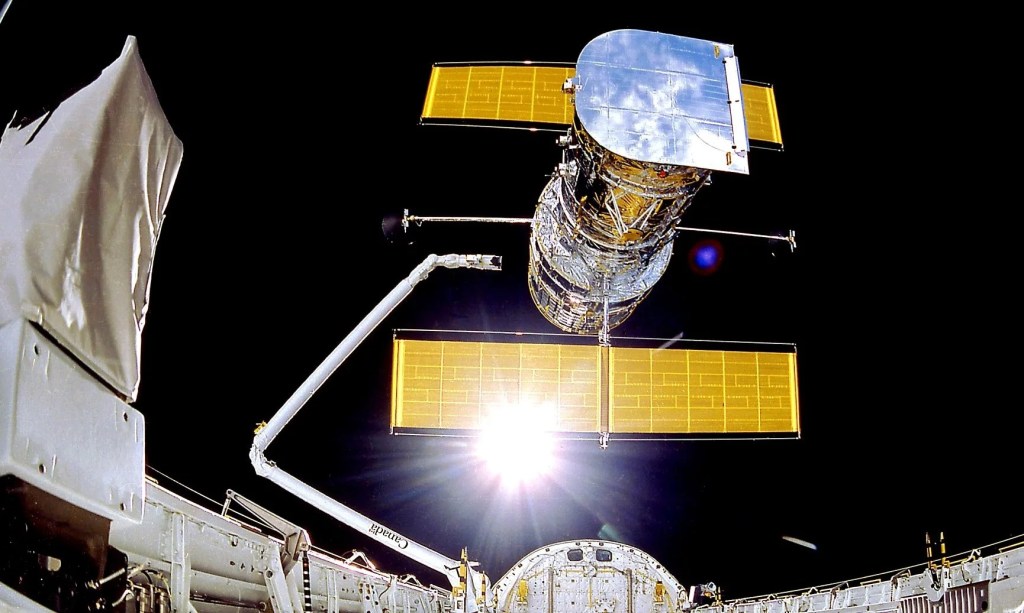
Hubble Oral Histories
These oral history interviews document the experiences of individuals who were involved in every aspect of NASA’s Hubble Space Telescope mission.
On The Shoulders of a Giant
Learn how Hubble and Webb work together to explore the cosmos. Their observations complement each other, providing us with a broad view of the universe.
Read More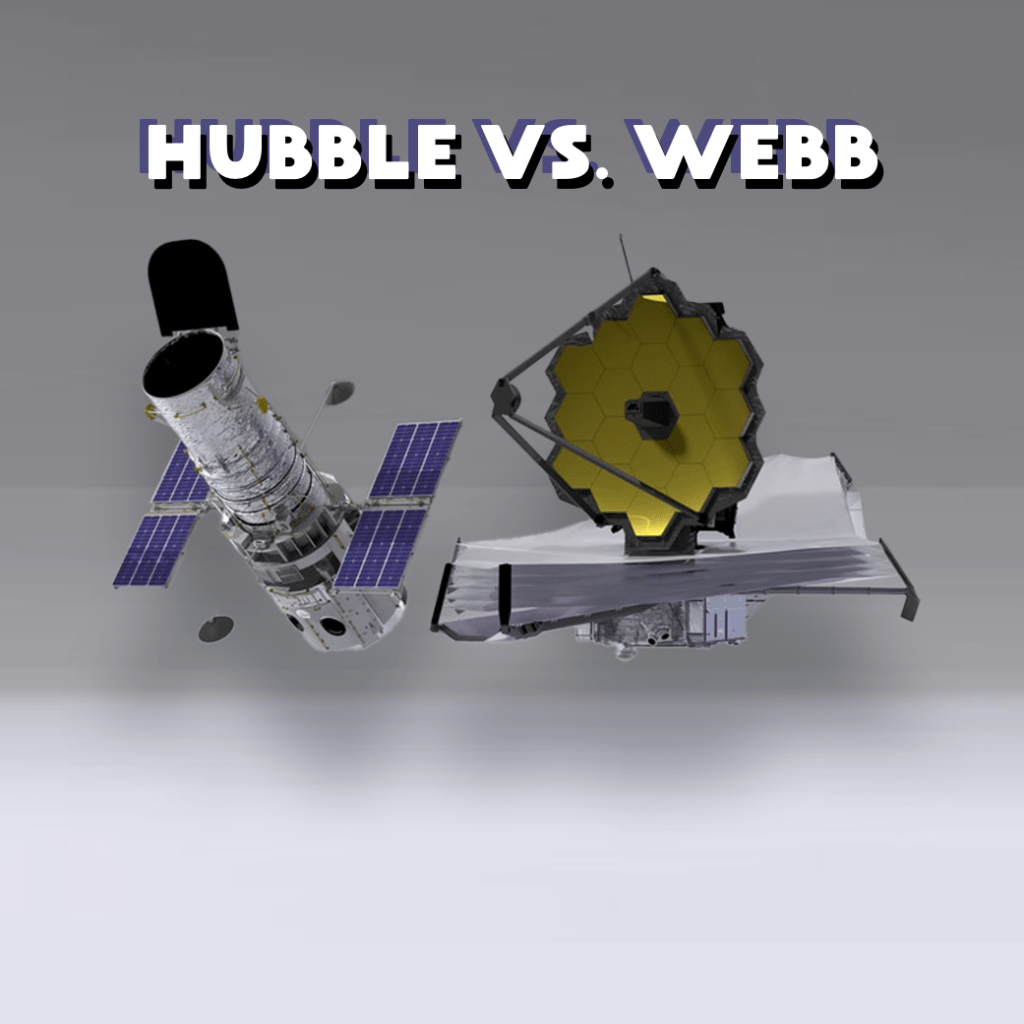
Hubble Observatory
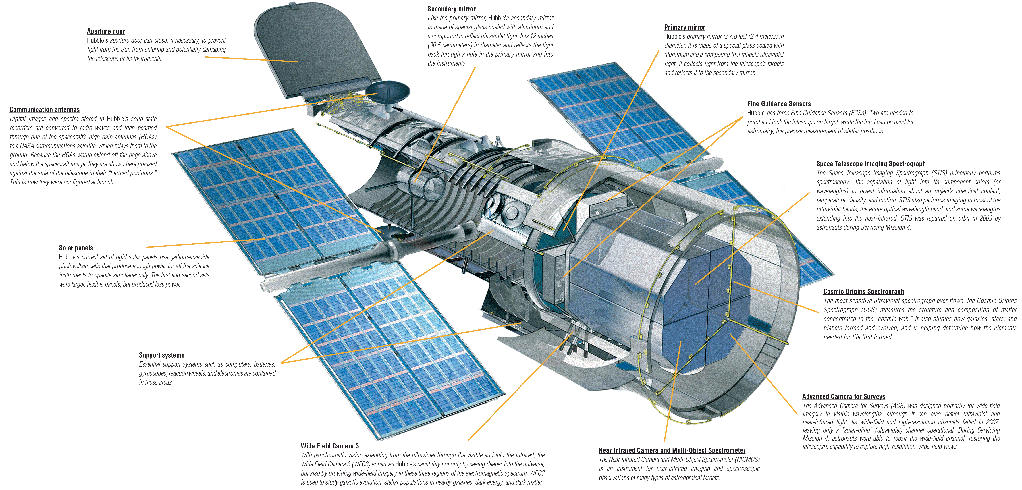
Hubble's Design
Hubble is the first space-based observatory specifically designed for servicing while in orbit. Learn about its optics, instruments, pointing control, and other systems.

Hubble Mission Operations
The Space Telescope Operations Control Center at NASA’s Goddard Space Flight Center in Greenbelt, Maryland is the engine that keeps Hubble operating 365 days a year, 24 hours a day.
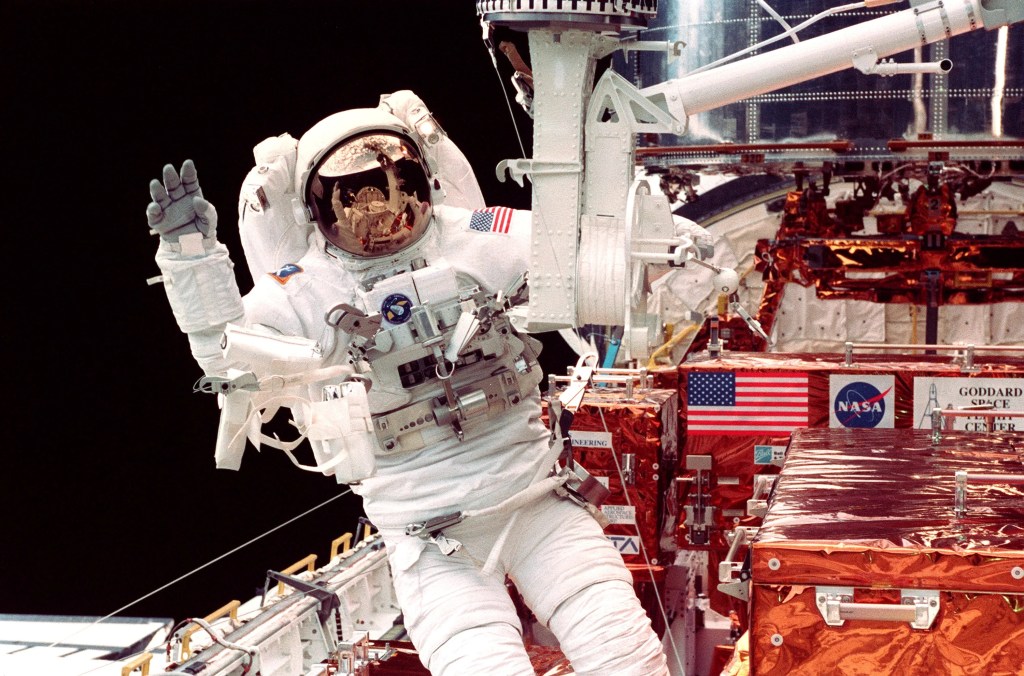
Missions to Hubble
Five servicing missions extended Hubble's life and increased its capabilities. Hubble’s serviceable design and modular components enabled upgrades that took advantage of advancements in technology.

Hubble Science Highlights
Hubble has affected every area of astronomy. Its most notable scientific discoveries reflect the broad range of research and the breakthroughs it has achieved.










